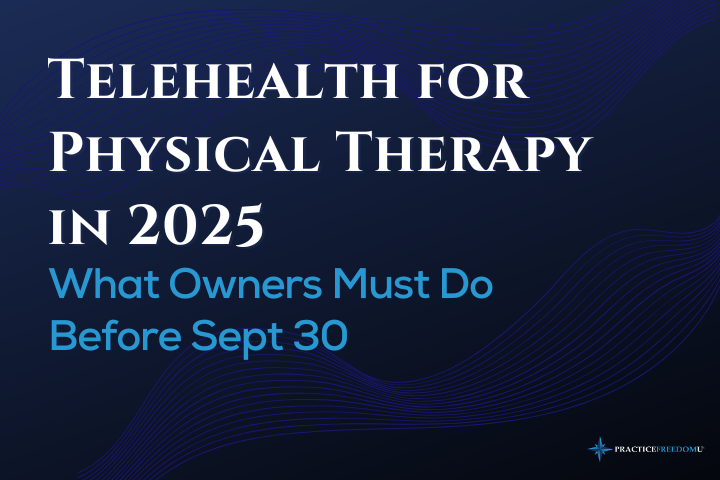If you own a clinic, your job is to lead, not to guess. On September 30, 2025, Medicare’s temporary telehealth flexibilities end unless Congress extends them. Right now, PTs and PTAs are allowed to furnish and bill telehealth to Medicare patients in their homes. That is in place only through September 30, 2025. After that, the rules snap back, most telehealth would require a rural originating site at a medical facility, and PTs would no longer be authorized telehealth providers for traditional Medicare unless the law changes. (Centers for Medicare & Medicaid Services)
This is not a reason to panic. It is a reason to decide.
What is actually changing
- Through Sept 30, 2025. Medicare patients can receive non-behavioral telehealth from home, no geographic limits. PTs, OTs, SLPs, and audiologists are allowed distant-site practitioners under the current extension.
- Starting Oct 1, 2025 if Congress does nothing. Patients generally must be in a rural area and at a medical facility for most telehealth, with some exceptions like ESRD home dialysis and mental health. PTs fall off the list of eligible telehealth practitioners under traditional Medicare. (Medicare)
- There is active advocacy to extend or make this permanent. APTA confirms the Sept 30 deadline and is pushing legislation such as H.R. 1614 to permanently authorize PTs and PTAs as Medicare telehealth providers. Support is bipartisan, timing is the question. (American Physical Therapy Association)
Bottom line, if Congress does not pass an extension by Sept 30, your Medicare tele-PT ends on Oct 1.
The risks if you wait and see
Revenue dip.
Any Medicare tele-PT appointments on or after Oct 1 will not be reimbursable under traditional Medicare if the waiver lapses, and you cannot bill retroactively if Congress fixes it later. Do not count on a backpay rescue. (Telehealth Resource Centers)
Patient access.
Home-bound and transportation-limited patients lose a proven access point. Continuity of care will suffer if you do not plan transitions now.
Operational stress.
Last-minute cancellations, denied claims, and mixed messages erode trust. Leaders remove confusion with clear decisions and scripts.
What to do this week

-
Run the numbers, then choose a policy.
-
Over-communicate with patients, and document.
-
Tighten the schedule.
-
Give your team the words.
-
Check other payers before you shut it all off.
Pull a list of all Medicare telehealth visits scheduled on or after Oct 1. Quantify visit count and dollars at risk. Decide now whether you will 1) convert to in-person, 2) continue telehealth as self-pay, or 3) cancel and reschedule. If there is a gap in federal law, assume no retroactive reimbursement.
Send a plain-English notice to affected patients explaining the federal change, your plan, and their options. If you offer self-pay telehealth, include an ABN so the financial responsibility is clear. This is not required, it is just good practice and protects everyone.
Pre-book in-person slots for affected patients now. Adjust therapist hours for the first two weeks of October to absorb conversions. Leaders remove bottlenecks before they show up at the front desk.
Script two or three talking points for schedulers and clinicians. Example, “As of Oct 1, Medicare may no longer cover tele-PT from home. We have a spot for you at the clinic, same day and time.” Consistency builds confidence.
Some Medicare Advantage plans and ACO arrangements may keep broader telehealth benefits even if traditional Medicare tightens. Verify your top payers.
Medium-term moves that make you stronger either way
Keep a smart hybrid.
Even if traditional Medicare tightens, telehealth remains valuable for other payers and for cash services like progress check-ins. HHS confirms the current flexibilities through Sept 30, and outlines what stays permanent for behavioral health. Build a clear menu so your team knows what is in-person by default and what can be virtual. (telehealth.hhs.gov)
Clean up coding and templates.
Update telehealth POS codes and modifiers where needed, and remove tele-PT from Medicare templates after Oct 1 if the law lapses. CMS’s 2025 FAQ spells out the temporary rules, so your documentation should match.
Make policy change a system, not a fire drill.
Assign one owner to watch CMS, HHS Telehealth, and APTA updates weekly, then brief the team. This reduces reactivity and keeps your focus on leadership and growth, not constant cleanup.
For owners who feel stuck
When the rules change, most owners do one of two things. They freeze, or they spin up busywork. Neither helps. Decide, communicate, move. This is how you protect care, keep revenue steady, and show your team what leadership looks like. You are not in the business of guessing what Congress will do. You are in the business of building a practice that runs on systems, not on hope.
If you want help turning this into a simple internal plan your team can run without you, we can do that together inside Practice Freedom U. We focus on removing owner-dependence and building a clinic that performs, with or without policy drama.
————————————————————-
Are you ready for a coach? Join the hundreds of physical therapy owners who are building the practice of their dreams with the support, guidance and direction of a Practice Freedom U Coach. Take the first step towards creating a business that sets you free by scheduling a Discovery Call



